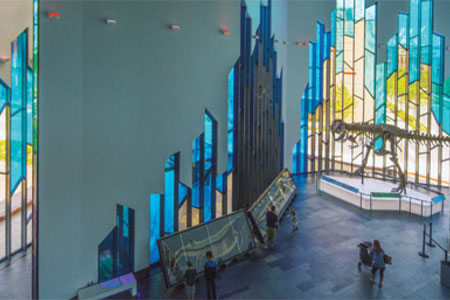 News
News 
Museum at Prairiefire, Kansas, USA
 Subscribe to FREE newsletter
Subscribe to FREE newsletter
| May 28, 2018 |
Established in 2010 as part of a partnership with the American Museum of Natural History (AMNH), the Museum at Prairiefire (MAP) is the centerpiece of a 60-acre mixed-use development in the Kansas City, Missouri suburb of Overland Park. MAP owner Merrill Companies, LLC, wanted a design as distinctive as its offering for visitors to view cuttingedge, world-renowned exhibits and artifacts from the AMNH.
Boston-based Verner Johnson, Inc. joined the project to generate conceptual drawings. Led by project architect Jonathan Kharfen, AIA LEED senior associate, the team created a series of concepts that depicted the regional nature of the museum. Kansas City–based JPI Glass served as the glazing contractor and self-performed 100 percent of the glass and glazing requirements for the complex project.
Kharfen took notice of the local practice of controlled prairie burns. These seasonal planned fires work as a rejuvenation tool, eliminating excess leaf litter and making it possible for plants to flower, produce seed and grow. With these images as inspiration, his team presented a concept reflecting the imagery of the tallgrass prairie, including one of its most unique aspects: prairie fire burns.
The museum, dubbed “The Jewel of Overland Park,” is registered with the certification goal of LEED®* Silver through the U.S. Green Building Council’s green building program and has received rave reviews since opening.
Design Highlights
The expansive lobby is enclosed in “lines of fire” – faceted vertical planes composed of tinted vision glazing, dichroic glass and iridescent stainless steel panels set in a composition invoking flames. The glass and steel shift color depending on perspective, creating a vibrant animate glow of color around the building. MAP is the only building in the United States to feature dichroic glass. The glass was manufactured by Goldray Industries using 3M film originally developed by NASA.Challenges
- Kharfen wanted the walls to appear as thin as possible in order to keep the appearance of flames. While the design called for a mullion system that could offer crisp corners and support the roof, columned spaces were dismissed because of their bul• ky look.
- After removing most of the curtain wall’s aluminum to maintain the aesthetic, the team needed a plan to accommodate the weight of the glass and support the roof. The application had to remain watertight, sustain high wind loads and maintain the gravitational loads associated with the structure’s weight.
- Setting the varying shapes and sizes of glass was difficult. The architect used a series of angled glass panels and punched opening windows with sloped tops to make the façades appear animated.
- The sloped tops proved to be a challenge in the numerous interior and exterior doors. Hinge placements were varied and could easily cause misalignment.

Solutions
- To accomplish the design’s a-one-of-kind look, the team at Verner Johnson worked with Kawneer architectural sales representatives and several company engineers.
- The architects determined Kawneer’s 1600 Wall System™2 Curtain Wall was a perfect fit for the MAP application, due in large part to its unique, vibrant features:
- A crisp, clean monolithic appearance and flexibility
- A veneer version of the stick-fabricated, pressure glazed curtain wall worked into the museum’s varied façade profile
- The veneer system featured a minimal depth interior aluminum mullion gutter that was attached to a steel grid tube structure to maintain the structural integrity of the facility.
- The project features two different types of glass – one laminated with dichroic film and the other a typical vision glass – as well as the angled panels necessary to accomplish the design. The team developed a numbered system to ensure that each piece of glass was cut and set in the correct order.
- Kawneer engineered two custom adjustable curtain wall corners to handle all the various angles, a huge improvement over the original 14-extrusion design.
- Areas of the sloped door frame were notched to make hinges function properly without affecting the overarching design. The Kawneer team delivered videos of the mock-up process to the construction team, ensuring a smooth transition from idea to reality.
1600 Wall System™2 Curtain Wall (custom four-sided structural silicone glazed veneer system)
Trifab™ 451UT Framing System
Trifab™ VersaGlaze™ 450
Framing System
500 Wide Stile Doors
Flushline™ Entrances
ARCHITECT
Verner Johnson, Inc.
Boston, Massachusetts, USA
GLAZING CONTRACTOR
JPI Glass
Kansas City, Missouri, USA
GENERAL CONTRACTOR
McCown Gordon Construction LLC
Kansas City, Missouri, USA
For other relevant searches, you might want to try:
